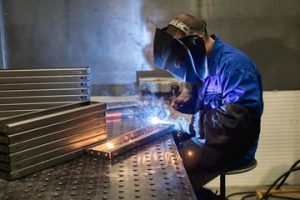
From tunnels carved beneath the Alps to towers touching the sky and bridges spanning seas, concrete is powering some of the most awe-inspiring creations in the world. Advanced concrete technologies help to improve durability, reduce environmental impact and simplify construction processes, supporting a smarter built environment.
Embracing innovations like self-healing concrete, 3D printing, and smart technologies is essential for construction professionals who want to keep pace with evolving industry standards. Companies like GK Construction Solutions are leading the way by integrating these advancements into their projects. These trends also support sustainability goals by reducing waste and emissions.
1. Biodegradable Additives
Concrete is one of the most popular construction materials globally. However, it is a significant contributor to carbon dioxide emissions and poses a major challenge as the world strives to achieve sustainability goals. New developments in the concrete industry could help address this issue, making it more eco-friendly and reducing its environmental impact.
Researchers at MIT recently discovered a way to improve existing concrete manufacturing processes by adding carbon-capturing additives. The process uses carbonation to transform cement into a high-performance material that can effectively absorb and store CO2. Moreover, the innovation does not compromise the structural integrity of concrete.
The addition of carbon-capturing additives significantly reduces the amount of CO2 emitted during the production of concrete. The technology also makes concrete more durable, allowing it to withstand the effects of climate change and other environmental hazards.
This innovative solution is an ideal choice for building companies that value sustainability and want to position themselves as environmentally responsible leaders. In fact, using this technology enables them to offer their clients environmentally-friendly construction solutions that will stand the test of time and strengthen customer relationships.
In the future, carbon-capturing additives will be available for a variety of different concrete applications. In addition to enhancing concrete durability, these additives can also make the construction process more efficient. For example, a concrete additive called PoreShield can prevent cracking and corrosion by sealing the concrete pores.
2. Self-Healing Concrete
Concrete is a highly durable material but requires regular maintenance and repairs to ensure structural integrity. In the United States alone, tens of billions of dollars are spent each year to repair crumbling concrete roads, bridges, and buildings.
Scientists have developed a new type of concrete that heals itself**, addressing one of the biggest challenges in preserving high-traffic concrete infrastructure. Self-healing concrete is infused with dormant limestone-producing bacteria that ‘wake up’ when water enters cracks, triggering limestone formation to fill and seal the gaps.
The concrete also contains fibres or capsules that contain adhesive liquids that break when the concrete cracks, releasing the liquid to heal the crack instantly**. This innovative solution significantly cuts maintenance costs and extends the lifespan of concrete structures.
While this innovation is still in the research stage, it holds the promise of transforming the construction industry. It could double road surface lifespan and dramatically reduce the number of potholes, while minimizing the impact on the environment and costing less to build**.
These innovations demonstrate how advancing technologies are revolutionizing the concrete industry and helping builders create better, safer, and more sustainable buildings and infrastructures. Whether it’s enhancing durability with 3D printing, creating self-healing concrete, or incorporating carbon to reduce environmental impact, these advancements are poised to transform the future of concrete construction. From tunnels carved beneath the mountains to skyscrapers that touch the clouds, this versatile building material is evolving to meet the demands of the modern world.
3. 3D Printing
The use of 3D printing technology is changing the way buildings are constructed. It allows for greater design freedom and faster construction processes. It also helps to reduce material waste and improve energy efficiency.
Using 3D printing, it is possible to create complex structures with intricate surface textures and freeform shapes. This is especially useful in modern architecture, where designers often want to push the boundaries of creativity. Traditionally, such forms would have been impossible to construct with traditional methods.
In addition, 3D printing can be used to produce concrete structures that are not only more cost-effective than their traditional counterparts but also more environmentally friendly. This is particularly true when the concrete is printed with recycled materials or biodegradable additives.
While the concept of 3D printing is relatively new, several companies have already started to use it in real-world projects. These include ICON and Lennar, which have built Wolf Ranch in Texas, a community of 100 homes that were constructed with 3D-printed concrete. Another project is La Citadelle Des Savoir-Faire, a sustainable building complex in France that was constructed with 3D-printed concrete.
According to a recent study, research on 3D concrete printing is growing rapidly. However, the collaboration between researchers from different institutions remains limited. The authors suggest that future studies should increase collaboration between different regions and countries to strengthen the application of this advanced technology in practice.
4. Digital Twins
In a time where data is the key to success, construction teams that embrace advanced technologies like digital twins and predictive maintenance will gain a competitive advantage. By bringing together building information modeling (BIM), augmented reality, and smart concrete technology, digital twins are revolutionizing the way projects are designed, managed, and built.
A digital twin is a virtual representation of a physical space or system that constantly collects and processes real-time data to optimize performance. When applied to precast concrete, this technology allows for efficient monitoring and optimization of a structure’s design, manufacturing, installation, and long-term operations and maintenance.
To maximize the benefits of this technology, firms must first ensure that their digital twins are fueled with accurate and consistent data. This can be achieved by deploying robust sensor technology and ensuring that proper data validation protocols are in place. Once this is accomplished, digital twins can provide a number of valuable insights that streamline workflows and enhance project outcomes.
For example, on a large project, a formwork company used SmartRock sensors to monitor internal concrete temperatures during curing. When the digital twin platform analyzed the sensor data, it identified that the concrete was under-curing in cooler zones, causing potential delays and labor inefficiency. By recommending adjustments to the curing schedule, the firm avoided costly delays and saved money by avoiding unnecessary labor costs. By enabling informed, timely decision-making, digital twins improve quality control throughout the construction process, minimizing redesigns and accelerating project completion.
5. Modular Precast Systems
Modular precast systems have gained traction as a construction method for high-rise buildings, accelerating project timelines without sacrificing quality. They allow for off-site fabrication of building components, allowing them to be quickly transported to the site and assembled for quick completion. This approach reduces construction time, labor costs, and material waste while maintaining a high level of consistency across structures.
Advanced precast concrete production technology is enabling more efficient workflows to help meet increasing demand for sustainable buildings and infrastructure projects. Automation and robotics improve precision and speed up production operations. These advances can also help mitigate skilled labor shortages.
The use of sensors on precast concrete structures enables remote monitoring and data analysis. These sensors provide real-time feedback on factors like temperature, moisture content, concrete curing times, and equipment performance. They allow contractors and facility managers to monitor structural health in real-time and make proactive interventions before issues escalate.
These innovations also allow architects and engineers to create more bespoke precast concrete elements that can be customized to suit specific project needs. For example, insulated concrete panels can be made to provide superior thermal performance that lowers energy consumption in buildings. They can also be designed to incorporate solar panels, enabling them to become self-sustaining energy hubs. This helps address the growing need for sustainable and resilient buildings that will help tackle climate change. The use of high-performance coatings also enables precast concrete to withstand harsh weather conditions, making it ideal for outdoor projects.
6. Smart Concrete
The world’s most-consumed building material is undergoing a revolution to become smarter. Incorporating sensor technology into concrete makes it easier to monitor structural health, prevent failures, and optimize maintenance and resource allocation.
Rather than bolting on probes to detect cracks, stress, or temperature changes, smart concrete incorporates the sensing capability directly into the mix. Carbon nanofibres or embedded sensor nodes form a conductive network that detects tiny shifts in the concrete’s volume electrical resistance. A handheld reader or cloud gateway converts this information into stress, crack width, or temperature data. The system’s continuous monitoring reduces inspection times, rework, and unscheduled shutdowns. It also helps contractors adhere to strict safety standards by enabling them to spot potential issues early and reduce load limits.
For example, smart concrete used in highway slabs can report on its strength and weakness directly to engineers, eliminating the need for destructive testing and reducing maintenance costs. The same technology can also feed real-time data into digital twins to inform road design and maintenance strategies, resulting in more cost-effective and sustainable infrastructure.
Other innovations, like self-healing concrete, can use bacteria or embedded microcapsules to repair cracks in a more environmentally friendly and efficient way. Combined with smart concrete, these technologies are shifting the construction industry’s focus from traditional sustainability and durability measures to performance-based standards. These advancements can transform how the industry builds, lowering carbon footprints and saving money by reducing maintenance costs.





